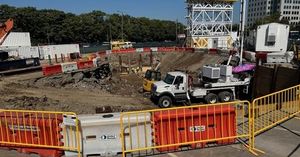On the morning of October 21, 2025, a wave of anxiety swept through the rural communities northwest of Santo Domingo, Dominican Republic. News broke that at least 80 miners had become trapped underground following a partial collapse at the Cerro de Maimón zinc and copper mine, a sprawling industrial site in the Monseñor Nouel province. The incident, which occurred at approximately 8:45 a.m., sent families rushing to the mine’s entrance, desperate for updates and hoping for good news.
The Cerro de Maimón mine, operated by Dominican Mining Corp—a subsidiary of the Australian company Perilya—spans 2,245 hectares (about 5,547 acres) and boasts reserves of roughly 6 million tons of copper and zinc. It’s a major player in the region’s mining sector, and its tunnels and open pits have long been a source of both economic activity and, at times, concern. The mine’s concession was acquired from Falconbridge Dominicana back in April 2002, marking the start of a new era of large-scale extraction in the area.
According to the Ministry of Energy and Mines, the collapse affected a tunnel within the mine, trapping the workers underground but not cutting them off entirely. In a statement released soon after the incident, the ministry reassured the public: “All miners were located underground in a safe area and were being lifted to upper ground.” As rescue teams mobilized, relatives waited anxiously above, hanging on every update from officials and company representatives.
Communication with the trapped miners was quickly established, and Corporación Minera Dominicana (CORMIDOM), another company involved in the operation, confirmed that the workers were in good health. “Technical and rescue teams are working to stabilize the area and ensure their exit,” CORMIDOM reported, adding that coordination with local authorities was ongoing and that further updates would be provided as the situation developed. The statement brought a measure of relief to the worried families clustered outside the mine’s gates, but the tension remained palpable until every last miner was accounted for.
By the afternoon, the Civil Defense Agency announced the news everyone had been hoping for: all 80 miners were rescued without injury or loss of life. “No one was injured or killed,” the agency confirmed, echoing the relief felt across the region. The successful rescue was a testament to the rapid response and coordination between government agencies, mine operators, and local emergency services. According to the Associated Press, the miners had been found in a secure area underground and were gradually lifted to safety, emerging to the cheers and tears of their loved ones.
The Cerro de Maimón mine is no stranger to danger. Local media and official statements highlighted that similar incidents have occurred in the past. In December 2021, a fatal collapse claimed the life of a miner, casting a long shadow over the site’s safety record. Then, in 2022, two workers—one Dominican, the other Colombian—found themselves trapped by an underground landslide and had to endure several harrowing days before being rescued. These previous incidents have kept mine safety at the forefront of local and national conversations, and this latest event has only sharpened those concerns.
For the families of the rescued miners, the ordeal was a stark reminder of the risks inherent in mining—a livelihood that, while often lucrative, can turn perilous in a moment. The area northwest of Santo Domingo is dotted with rural communities that depend heavily on the mine for employment and economic stability. On the day of the collapse, these communities were united in worry, their collective anxiety only dissipating as news of the successful rescue spread.
Rescue operations in mining disasters are always fraught with uncertainty. In this case, the quick identification of a safe area underground and the maintenance of communication with the trapped workers proved crucial. The Ministry of Energy and Mines, in coordination with technical and rescue teams, worked methodically to stabilize the affected tunnel and bring the miners to the surface. The process was painstaking but effective, and by late afternoon, all 80 miners had been safely extracted.
According to Devdiscourse, the dramatic rescue operation unfolded in full view of the public, with anxious families and media outlets gathered outside the mine. The sight of workers emerging unscathed was met with jubilation—a rare moment of collective relief in a region all too familiar with mining tragedies. The Civil Defence Agency’s confirmation that there were “no injuries or deaths” was the final reassurance that the worst had been averted.
Yet, the incident has reignited debates about mine safety in the Dominican Republic. The Cerro de Maimón mine’s history of accidents—most notably the fatal collapse in 2021 and the protracted rescue of two workers in 2022—has raised questions about the adequacy of safety protocols and emergency preparedness. While the successful rescue this time was cause for celebration, many in the community and beyond are calling for a thorough review of mining practices to prevent future disasters.
The mine’s operator, Dominican Mining Corp, has stated its commitment to ongoing safety improvements. As the company manages one of the largest copper and zinc reserves in the country, the stakes are high—not just for the miners, but for the broader economy. The mine’s output is a significant contributor to local employment and government revenues, making its continued operation a matter of both economic necessity and public scrutiny.
For now, the focus remains on the safe return of the rescued miners to their families and the gratitude of a community that, for a few tense hours, feared the worst. The Ministry of Energy and Mines, along with CORMIDOM and the Civil Defence Agency, has pledged to continue monitoring conditions at the mine and to keep the public informed of any further developments.
As the dust settles and the rescued miners reunite with their families, questions about the future of mining safety in the Dominican Republic linger. The events of October 21, 2025, may well serve as a catalyst for renewed efforts to ensure that those who risk their lives underground can do so with greater assurance of returning home safely at the end of each shift.






